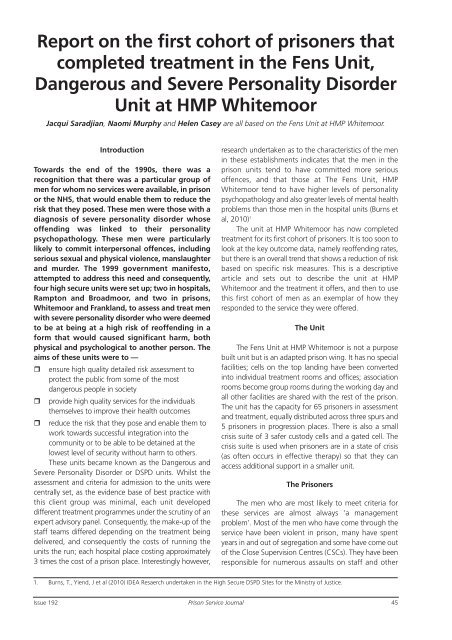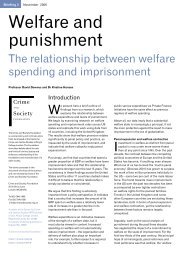PRISON SERVICE
PRISON SERVICE
PRISON SERVICE
- No tags were found...
You also want an ePaper? Increase the reach of your titles
YUMPU automatically turns print PDFs into web optimized ePapers that Google loves.
Report on the first cohort of prisoners thatcompleted treatment in the Fens Unit,Dangerous and Severe Personality DisorderUnit at HMP WhitemoorJacqui Saradjian, Naomi Murphy and Helen Casey are all based on the Fens Unit at HMP Whitemoor.IntroductionTowards the end of the 1990s, there was arecognition that there was a particular group ofmen for whom no services were available, in prisonor the NHS, that would enable them to reduce therisk that they posed. These men were those with adiagnosis of severe personality disorder whoseoffending was linked to their personalitypsychopathology. These men were particularlylikely to commit interpersonal offences, includingserious sexual and physical violence, manslaughterand murder. The 1999 government manifesto,attempted to address this need and consequently,four high secure units were set up; two in hospitals,Rampton and Broadmoor, and two in prisons,Whitemoor and Frankland, to assess and treat menwith severe personality disorder who were deemedto be at being at a high risk of reoffending in aform that would caused significant harm, bothphysical and psychological to another person. Theaims of these units were to — ensure high quality detailed risk assessment toprotect the public from some of the mostdangerous people in society provide high quality services for the individualsthemselves to improve their health outcomes reduce the risk that they pose and enable them towork towards successful integration into thecommunity or to be able to be detained at thelowest level of security without harm to others.These units became known as the Dangerous andSevere Personality Disorder or DSPD units. Whilst theassessment and criteria for admission to the units werecentrally set, as the evidence base of best practice withthis client group was minimal, each unit developeddifferent treatment programmes under the scrutiny of anexpert advisory panel. Consequently, the make-up of thestaff teams differed depending on the treatment beingdelivered, and consequently the costs of running theunits the run; each hospital place costing approximately3 times the cost of a prison place. Interestingly however,research undertaken as to the characteristics of the menin these establishments indicates that the men in theprison units tend to have committed more seriousoffences, and that those at The Fens Unit, HMPWhitemoor tend to have higher levels of personalitypsychopathology and also greater levels of mental healthproblems than those men in the hospital units (Burns etal, 2010) 1The unit at HMP Whitemoor has now completedtreatment for its first cohort of prisoners. It is too soon tolook at the key outcome data, namely reoffending rates,but there is an overall trend that shows a reduction of riskbased on specific risk measures. This is a descriptivearticle and sets out to describe the unit at HMPWhitemoor and the treatment it offers, and then to usethis first cohort of men as an exemplar of how theyresponded to the service they were offered.The UnitThe Fens Unit at HMP Whitemoor is not a purposebuilt unit but is an adapted prison wing. It has no specialfacilities; cells on the top landing have been convertedinto individual treatment rooms and offices; associationrooms become group rooms during the working day andall other facilities are shared with the rest of the prison.The unit has the capacity for 65 prisoners in assessmentand treatment, equally distributed across three spurs and5 prisoners in progression places. There is also a smallcrisis suite of 3 safer custody cells and a gated cell. Thecrisis suite is used when prisoners are in a state of crisis(as often occurs in effective therapy) so that they canaccess additional support in a smaller unit.The PrisonersThe men who are most likely to meet criteria forthese services are almost always ‘a managementproblem’. Most of the men who have come through theservice have been violent in prison, many have spentyears in and out of segregation and some have come outof the Close Supervision Centres (CSCs). They have beenresponsible for numerous assaults on staff and other1. Burns, T., Yiend, J et al (2010) IDEA Resaerch undertaken in the High Secure DSPD Sites for the Ministry of Justice.Issue 192 Prison Service Journal45











